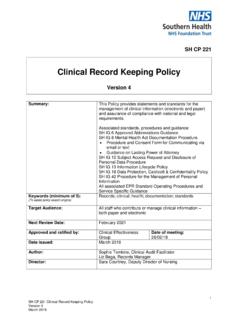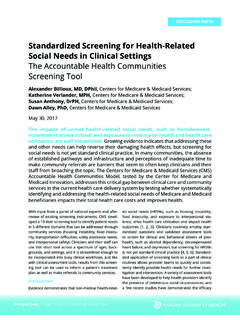Transcription of Seclusion and Long-term Segregation Policy
1 SH CP 107. Seclusion and Long-term Segregation Policy Version 8. Summary: The aims of the Policy are: 1) To ensure the physical and emotional safety and wellbeing of the patient. 2) To ensure the safety of others from severe behavioural disturbance which likely to cause harm to others;. 3) To ensure the patient receives the care and support rendered necessary by their Seclusion both during Seclusion and after it has taken place. 4) To minimise the frequency and duration of Seclusion and prevent any inappropriate use of Seclusion . 5) To distinguish between Seclusion and)other restrictive practices and psychological behaviour therapy interventions (such as time out'.
2 6) To ensure proper monitoring of periods of Seclusion and to provide a complete record of all periods of Seclusion and audit. Keywords (minimum of 5): Seclusion , Long-term Segregation (To assist Policy search engine). Target Audience: All clinical and medical staff employed by Southern Health NHS. Foundation Trust. Next Review Date: April 2019. Approved and Ratified by: Management of Violence and Date of meeting: Aggression Committee TBC. AMH Quality and Safety Forum TBC. LD Quality and Safety Meeting 9 April 2015. Date issued: January 2017. Author: Dr Mayura Deshpande, Interim Associate Medical Director (Quality, Governance & Patient Safety). Sponsor: Dr Lesley Stevens, Medical Director 1.
3 Seclusion and Long-term Segregation Policy Author: Dr Mayura Deshpande Version: 8. April 2018. Version Control Change Record Date Author Version Page Reason for Change July Siven Rungien 3 Throughout 2014. October Siven Rungien 3 Feedback re: 2014 Seclusion terminology and Long-term Segregation procedure. Need to place greater emphasis on medical involvement in Seclusion practice January Dr Mayura 4 Further feedback on clarifying the role of Doctors in the 2015 Deshpande Seclusion review process. Simplified documentation. April Dr Mayura 5 Throughout to reflect revised MHA Code of Practice 2015. 2015 Deshpande, Dr Jim Ormsby, Tim Coupland, Siven Rungien May Siven Rungien 5 6, 13 i) Definition reflects Code of Practice.
4 2015 ii) Correction re medical reviews by consultant psychiatrist;. iii) General amendments where necessary to illustrate that Code sets minimum safeguards required. Jan Siven Rungien 5 10 i) NHS England Reporting Requirements 2016 ii) NHS England Notification Document added iii) Part 8 Person-in-charge decision' to end Seclusion added to Seclusion care pathway. 24 iv) Addition to supporting references January Louise Hartland 5 26 Updated TNA (Appendix 2). 2016. August Dr Mayura 6 8 Specific section on children and young people 2016 Deshpande Seclusion flowchart of reviews added to suite of documents January Dr Mayura 7 Various Change from paper-based documentation to electronic 2017 Deshpande patient record system; new section added on Seclusion reviews at times of major disruptions 28/2/18 Louise Hartland 7 27 Updated TNA (Appendix 2).
5 9/4/18 Dr Mayura 7 Policy reviewed no changes needed currently. Review Deshpande/ date extended for further year to April 2019. Updated Trust Siven Rungien logo 23/4/18 Louise Hartland 8 27-29 Training Needs Analysis (TNA) updated Reviewers/contributors Name Position Version Reviewed &. Date Sarah Baines Head of Nursing and Quality Mental Health February 2013. and Learning Disabilities Management of Violence and Security Lead, Service User and Staff side As above Committee members representative, LEAD MOVA trainer Helen Eunson Consultant Practitioner (Nurse) Trainee April 2014. John Rose Service User Group Representative April 2014. Fiona Hartfree Divisional Lead Nurse AMH July 2014.
6 Dr Mayura Deshpande Clinical Service Director Bluebird House July 2014. Tim Coupland Head of Nursing, AHP and Quality July 2014. Siven Rungien Mental Health Act Manager July 2014. Michael Crutchley Modern Matron, Bluebird House July 2014. Julie Cooper MH Lead for Organisational Learning July 2014. Matthew Stephenson Consultant Psychiatrist July 2014. Dr Jennifer Dolman Clinical Director, Learning Disability Division July 2014. Lesley Herbert Consumer Advisor July 2014. Dr Jim Ormsby Consultant Forensic Psychiatrist V. 5 March 2015. Dr Mayura Deshpande Clinical Service Director, Bluebird House V. 5 March 2015. Tim Coupland Head of Nursing, AHP and Quality V.
7 5 March 2015. DAC Beachcroft LLP Solicitors V. 5 May 2015. Dr Mayura Deshpande, Dr Elliott Clinical Service Director, Bluebird House & V 6 August 2016. Riordan-Eva ST4 in Forensic Psychiatry, Ravenswood House 2. Seclusion and Long-term Segregation Policy Author: Dr Mayura Deshpande Version: 8. April 2018. CONTENTS. Page 1. Introduction 4. 2. Scope 4. 3. SHFT Practice Principles shaping this Policy 4. 4. General Principles: Looking after the patient in Seclusion and 6. Long-term Segregation 5. General Principles: Code of Practice Definition of Seclusion 6. The Seclusion Care Pathway 11. 6. Initiation of Seclusion 11. 7. Care of the Patient in Seclusion 13.
8 8. Reviews during Seclusion 14. 9. Seclusion Care Plan 17. 10. Extended Seclusion periods 17. 11. Ending Seclusion 18. 12. Debriefing and re-integration to ward 18. 13. Reporting & Monitoring 19. 14. Seclusion reviews at times of major disruption 19. Long-term Segregation procedure 20. 15. Code of Practice Definition of Long-term Segregation and general 20. principles 16. Long-term Segregation environment 21. 17. Initiation of Long-term Segregation 21. 18. Care of patient in Long-term Segregation 21. 19. Review during Long-term Segregation 22. 20. Long-term Segregation care plan 23. 21. Termination of Long-term Segregation 24. 22. Debrief and re-integration to ward 24.
9 23. Reporting & monitoring 24. 24. Supporting References 24. Appendices A1 Addresses of current designated Seclusion rooms 26. A2 Training Needs Analysis (TNA) 27. A3 Equality Impact Assessment (EqIA) 30. 3. Seclusion and Long-term Segregation Policy Author: Dr Mayura Deshpande Version: 8. April 2018. Seclusion and Long-term Segregation Policy 1. Introduction Southern Health NHS Foundation Trust ( the Trust ) recognises that it has a legal duty so far as is reasonably practicable to protect its patients and staff. The Trust is committed to supporting staff, patients, cares and visitors in the event of adverse situations and recognises that providing a safe environment is paramount to success.
10 The Trust will ensure the physical and emotional safety and wellbeing of the services user remains a priority for all staff at all times. Staff will ensure that services users receive the care and support rendered necessary both during and after Seclusion has taken place. However, the Trust will not tolerate violent, aggressive, antisocial or abusive behaviour towards its staff during the course of their duty. Decisive action will be taken to protect staff. This Policy stems from a framework to balance the needs of patients to receive care with the need to protect staff and others from violence and aggression by the containment of severe behavioural disturbance which is likely to cause harm to others.














